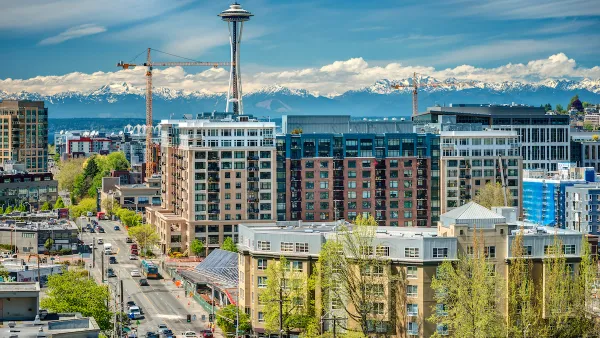An approved, 55 micro-unit, mixed-use development with no parking sited on a transit corridor with 15-minute headways has been halted by a legal ruling after neighborhood opponents proved the bus was not meeting its schedule.
"The 15-minute figure is important because it’s the metric the Seattle City Council set back in 2010 as one of the requirements for allowing developers to build apartment complexes in urban villages without providing parking," reports Daniel Person for Seattle Weekly.
A neighborhood coalition, Livable Phinney, formed to oppose the Phinney Ridge micro-unit development known as Phinney Flats, obtained data to prove that the bus wasn't precisely meeting its schedule, although to this correspondent, the deviance appeared minor.
Earlier this year, a PhD statistician analyzed bus data over the course of several months and determined that more than 15 minutes passed between buses about 38 percent of the time; 10 percent of the time there was a 20 minute gap, and 2 percent of the time a 25 minute gap.
But Livable Phinney pressed the letter of the law to its advantage. In front of a hearing examiner in May, the neighbors argued that 15 minutes means 15 minutes, and the city can’t rely on bus time tables as evidence that the requirement is being met. In his July 24 ruling, hearing examiner Ryan Vancil agreed the city “cannot simply ignore” data that shows buses are not coming every 15 minutes.
Coalition leader Irene Wall expressed her satisfaction in the group's July 26 press release:
“This is the first time that statistical evidence has been used to show that bus schedules are meaningless in the ever-increasing traffic congestion in Seattle,” Wall explained. “When a bus is unreliable, the City cannot expect people to forego [sic] their cars and rely on unreliable public transportation, and people who ride the bus also own cars.”
However, the city code requires other transportation demand management measure to supplement transit frequency. "In lieu of a parking space, they'll need to provide tenants with transit passes and memberships in car and bikeshare services," notes a May 2015 post on Seattle's innovative densification and residential parking policies.
"The ruling does not kill the project," adds Person. "Rather, it sends the permit back to Seattle Department of Construction and Inspections for further review. Transit was not the only issue the hearing examiner found fault with, though it did have the farthest reaching implications."
Phinney Flats is part of the solution to the problem expressed in Thursday's post, "New Levels of Car Dependence Follow Seattle's Growth." If Seattle is going to continue to grow rapidly, it needs to have innovative, flexible parking policies that reduce car ownership while increasing residential density. Livable Phinney's gain, even if only temporary, is greater Seattle's loss.
Hat tip to L.A. Metro Transportation Library.
FULL STORY: Late Buses Could Spell Trouble for Denser Development in Seattle

National Parks Layoffs Will Cause Communities to Lose Billions
Thousands of essential park workers were laid off this week, just before the busy spring break season.

Retro-silient?: America’s First “Eco-burb,” The Woodlands Turns 50
A master-planned community north of Houston offers lessons on green infrastructure and resilient design, but falls short of its founder’s lofty affordability and walkability goals.

Delivering for America Plan Will Downgrade Mail Service in at Least 49.5 Percent of Zip Codes
Republican and Democrat lawmakers criticize the plan for its disproportionate negative impact on rural communities.

Test News Post 1
This is a summary

Test News Headline 46
Test for the image on the front page.

Balancing Bombs and Butterflies: How the National Guard Protects a Rare Species
The National Guard at Fort Indiantown Gap uses GIS technology and land management strategies to balance military training with conservation efforts, ensuring the survival of the rare eastern regal fritillary butterfly.
Urban Design for Planners 1: Software Tools
This six-course series explores essential urban design concepts using open source software and equips planners with the tools they need to participate fully in the urban design process.
Planning for Universal Design
Learn the tools for implementing Universal Design in planning regulations.
EMC Planning Group, Inc.
Planetizen
Planetizen
Mpact (formerly Rail~Volution)
Great Falls Development Authority, Inc.
HUDs Office of Policy Development and Research
NYU Wagner Graduate School of Public Service




























